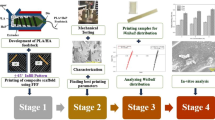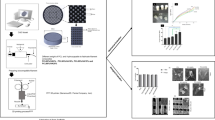Abstract
Three-dimensional porous poly-lactic acid (PLA) scaffold was fabricated using fused deposition modeling (FDM) method including 30%, 50% and 70% nominal porosity. Study of phases in initial polymeric material and printed scaffolds was done by X-ray diffraction (XRD), and no significant phase difference was observed due to the manufacturing process, and the poly-lactic acid retains its crystalline properties. The results of the mechanical properties evaluation by the compression test show that the mechanical properties of the scaffold have decreased signifcantly with increasing the porosity of scaffold. The microstructure of scaffolds were studied by scanning electron microscope (SEM), showing that the pores had a regular arrangement and their morphology changed with porosity change. The mechanical properties of the poly-lactic acid scaffolds printed using fused deposition modeling, can be adapted to the surrounding tissue, by porosity change.
Similar content being viewed by others
References
Khodaei Mohammad, Meratian Mahmood, Savabi Omid, et al. The Effect of Sintering Temperature on the Properties of Porous Titanium Implant Manufactured by Space Holder Method[J]. Journal Advanced Processes in Materials Engineering, 2015, 9(3): 1–9
Hosseini Shahin, Sadrnezhaad Sayed Khatiboleslam, Ekrami Aliakbar. Phase Transformation Behavior of Porous NiTi Alloy Fabricated by Powder Metallurgical Method[J]. Materials Science and Engineering C, 2009, 29(7): 2 203–2 207
Corcione Carola Esposito, Gervaso Francesca, Scalera Francesca, et al. Highly Loaded Hydroxyapatite Microsphere/ PLA Porous Scaffolds Obtained by Fused Deposition Modelling[J]. Ceramics International, 2019, 45(2): 2 803–2 810
Lin Weiyi, Shen Hongyao, Xu Guanhua, et al. Single-layer Temperature-adjusting Transition Method to Improve the Bond Strength of 3D-printed PCL/PLA Parts[J]. Composites Part A, 2018, 115: 22–30
Kun Krisztián. Reconstruction and Development of a 3D Printer Using FDM Technology[J]. Procedia Engineering, 2016, 149: 203–211
Rinaldi Marianna, Ghidini Tommaso, Cecchini Federico, et al. Additive Layer Manufacturing of poly (Ether Ether Ketone) via FDM[J]. Composites Part B, 2018, 145(15): 162–172
Gomez-Gras Giovanni, Jerez-Mesa Ramón, Travieso-Rodriguez J, et al. Fatigue Performance of Fused Filament Fabrication PLA Specimens[J]. Materials & Design, 2018, 140(15): 278–285
Wang Hao, Zhi Wei, Lu Xiong, et al. Comparative Studies on Ectopic Bone Formation in Porous HA Scaffolds with Complementary Pore Structures[J]. Acta Biomaterialia, 2013, 9(9):8 412–8 413
Tan Lili, Yu Xiaoming, Wan Peng, et al. Biodegradable Materials for Bone Repairs: A Review[J]. J. Mater. Sci. Technol., 2013, 29(6): 503–513
Bhatia Sujata K. Biomaterials for Clinical Applications[M]. New York: Springer, 2010
Ostrum, Robert F. Biomechanics in Orthopedic Trauma. Bone Fracture and Fixation[J]. The Journal of Bone and Joint Surgery, 1994, 76(9): 1 438–1 438
Wieding Jan, Wolf Andreas, Bader Rainer. Numerical Optimization of Open-Porous Bone Scaffold Structures to Match the Elastic Properties of Human Cortical Bone[J]. Journal of Mechanical Behavior of Biomedical Material, 2014, 37: 56–68
Mohseni Kouchesfahani Homa, Sanamiri Khadije, Hashemitabar Mahmoud. Application of Alginate Capsules as a Three Dimensional Scaffold for Differentiation of Wharton’s Jelly Mesenchymal Stem Cells to Definitive Endoderm[J]. Arak Medical University Journal, 2014, 17(85): 54–66
Wan Lu, Zhang Yanhua. Jointly Modifed Mechanical Properties and Accelerated Hydrolytic Degradation of PLA by Interface Reinforcement of PLA-WF[J]. Journal of the Mechanical Behavior of Biomedical Materials, 2018, 88: 223–230
Simmons Heather, Kontopoulou Marianna. Hydrolytic Degradation of Branched PLA Produced by Reactive Extrusion[J]. Polymer Degradation and Stability, 2018, 158: 228–237
Author information
Authors and Affiliations
Corresponding author
Rights and permissions
About this article
Cite this article
Khodaei, M., Amini, K. & Valanezhad, A. Fabrication and Characterization of Poly Lactic Acid Scaffolds by Fused Deposition Modeling for Bone Tissue Engineering. J. Wuhan Univ. Technol.-Mat. Sci. Edit. 35, 248–251 (2020). https://doi.org/10.1007/s11595-020-2250-4
Received:
Accepted:
Published:
Issue Date:
DOI: https://doi.org/10.1007/s11595-020-2250-4




